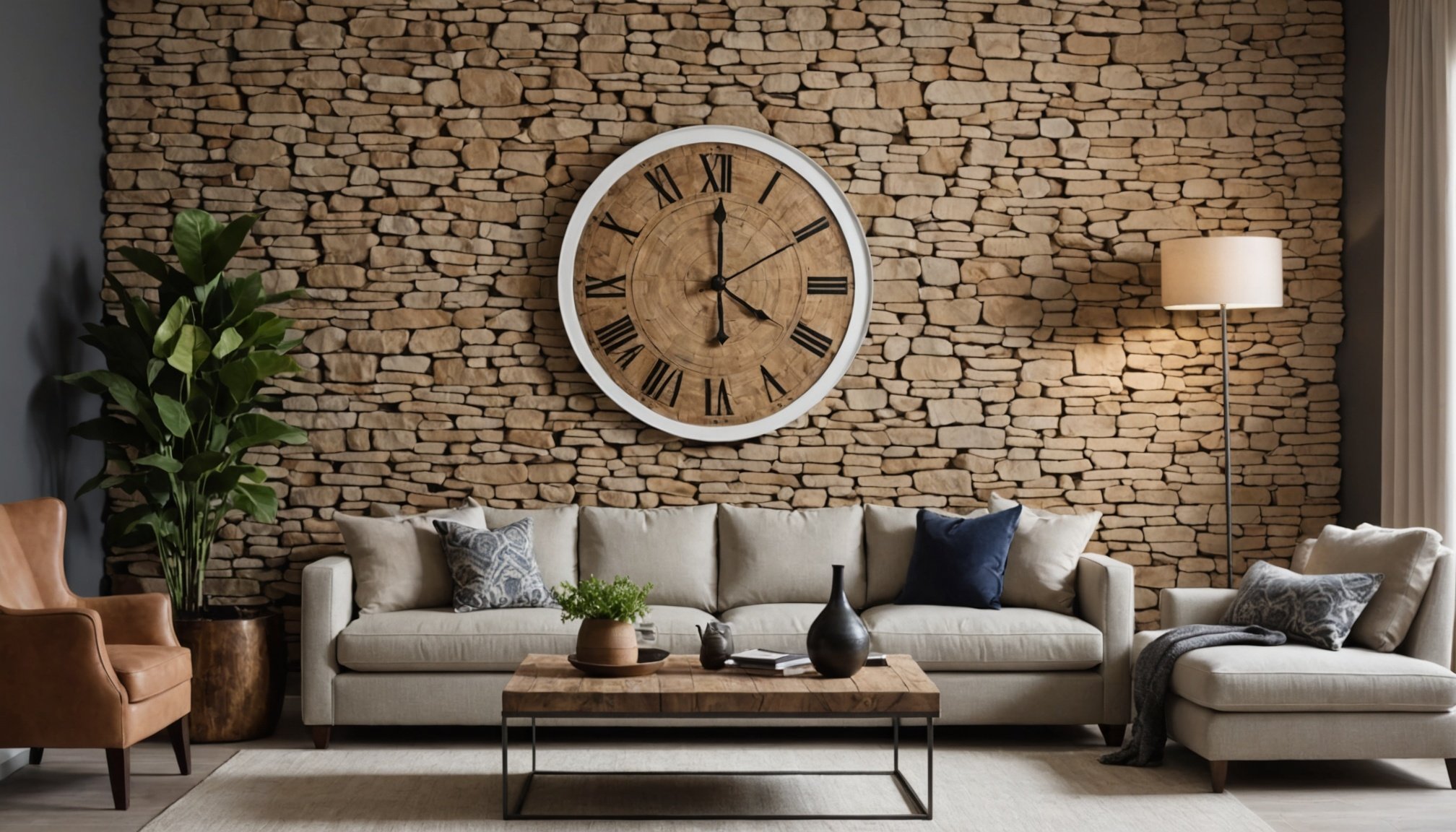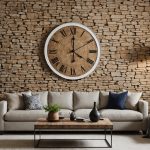Overview of Natural Materials in Home Décor
Integrating natural materials into home décor not only adds an aesthetic charm but also promotes a healthier living environment. Let’s delve into its components and advantages.
Definition and Types
Natural materials, such as wood, stone, cotton, and wool, come directly from nature without extensive modification. As a result, these materials are versatile, catering to diverse design styles—from rustic to contemporary. Their earthy tones and textures invite warmth and elegance into any space.
Have you seen this : Transforming your mind: how gratitude journaling enhances mental wellbeing
Aesthetic Appeal and Versatility
The versatility of natural materials enhances their appeal. Wood brings a cozy and inviting feel, while stone adds a touch of luxury. Cotton and wool fabrics offer comfort, perfect for textiles and upholstery. The endless possibilities for mixing and matching these materials ensure a unique and personalised design.
Environmental Advantages and Sustainability
Choosing natural materials aligns well with sustainable design practices. They are typically biodegradable and have a lower carbon footprint compared to synthetic options. Furthermore, sustainable sourcing and responsible manufacturing processes contribute to conserving ecosystems. By opting for these choices, you are not only beautifying your home but also supporting environmental conservation efforts.
Also read : Essential strategies for cultivating a thriving scalp: unlock the secrets to luscious hair
Aesthetic Benefits of Embracing Natural Materials
Natural materials not only add an aesthetic appeal to spaces but also enhance visual comfort. Incorporating natural textures like wood and stone can transform a room by creating a warm and inviting atmosphere. These textures draw inspiration from the outdoors, promoting tranquillity and connection with nature.
Incorporating textures and colors found in nature is key to achieving this look. Natural colors like earthy browns, forest greens, and ocean blues can be seamlessly integrated into a room’s design. These hues complement natural textures, resulting in a cohesive and soothing environment.
Currently, there are several design trends emphasizing natural elements. For instance, biophilic design prioritises connectivity to the natural environment through architecture. This trend focuses on features like green walls or large windows that allow for ample daylight and views of surrounding landscapes. Similarly, wabi-sabi celebrates the beauty in imperfection, utilising raw and unrefined materials to showcase authenticity.
By integrating natural materials and embracing these trends, one can create a visually appealing and comforting space. The shift towards these elements reflects a growing desire for environments that soothe the mind and promote well-being. This highlights the enduring power of nature-inspired design in modern spaces.
Environmental Benefits of Natural Materials
Opting for eco-friendly materials plays a significant role in maintaining the world’s ecological balance. As society becomes increasingly aware of the environmental impacts of consumer choices, the reduced carbon footprint associated with using natural resources garners more attention. Natural materials, such as wood, bamboo, and cotton, are often more sustainable than their synthetic counterparts, as they are derived from renewable resources. These materials can be replenished over time, unlike finite resources such as petroleum used in the production of many synthetic items.
Moreover, the lifecycle of natural materials typically features a lower environmental impact from production through to disposal. For example, the production of wood furniture or cotton textiles generally results in fewer emissions and pollutants compared to their synthetic equivalents. Additionally, when natural materials reach the end of their lifecycle, they tend to decompose more naturally, minimizing waste and reducing landfills.
Renewable resources also offer a practical advantage: they can contribute to sustainable design by being integrated into durable products that support long-term ecological health. Embracing these materials not only helps in sustainability efforts but also propels a shift towards a more eco-friendly future.
Practical Tips for Using Natural Materials in Décor
Incorporating natural materials into your home décor can transform your space into a haven of tranquility. If you’re searching for practical home improvement tips, look no further. From rustic wood to smooth stones, there are abundant ways to incorporate nature’s beauty.
Creative Ideas by Room
Consider adding a wooden ladder as a bathroom towel rack. In the living room, a stone coffee table can add elegance. Bamboo blinds are perfect for creating a peaceful atmosphere in your bedroom. These elements not only enhance aesthetics but also invite nature in.
Sourcing Materials Sustainably
When you’re on the hunt for these materials, sourcing them sustainably is key. Seek out suppliers who use eco-friendly harvesting methods. This helps maintain the Earth’s balance while ensuring you receive high-quality products.
Simple DIY Projects for Beginners
Transform leftover stones into a chic tabletop centerpiece. Craft a driftwood coat rack for your hallway. These projects are manageable even for first-time DIY enthusiasts. They provide a sense of accomplishment and a unique touch to your home. Embrace these home improvement tips and transform your space into a natural retreat.
Cost Implications of Using Natural Materials
Natural materials in home decoration often raise concerns about affordability. However, there are budget-friendly options that can make them accessible. When comparing costs, natural materials may initially appear more expensive than synthetic alternatives. Yet, their inherent durability and longevity often lead to long-term savings. For instance, a wooden floor can withstand wear much better than a synthetic counterpart, reducing repair and replacement costs over the years.
The value of sustainability is another factor to consider. Investing in natural materials supports eco-friendly practices, which appeals to an environmentally conscious mindset. This approach often results in products made with less harmful processing, contributing to a healthier home environment.
However, for those on a strict budget, there are strategies to incorporate natural materials affordably. Prioritising key areas for investment, such as furniture pieces or flooring, can allow for high-impact yet budget-conscious decorating. Additionally, mixing and matching with synthetic options in less visible areas or accessories can help maintain a balance.
Ultimately, while the upfront investment might be higher, natural materials offer a combination of aesthetic appeal, sustainability, and cost-effectiveness over time, making them a practical choice for any home decorator looking to maximise their pricing value.
Examples and Case Studies of Natural Material Use
Exploring natural materials brings unique charm to various settings. Let’s dive into inspiring case studies showcasing their potential in both residential and commercial environments. Each transformation exhibits innovative application, promising to redefine how we perceive natural integration.
Residential Spaces
In residential spaces, using natural materials like reclaimed wood and stone can completely transform a home. For instance, a before-and-after look at a small urban apartment post-renovation reveals how a blend of natural textures introduces warmth and elegance. Walls clad in bamboo and flooring with cork elevate aesthetics, preceding a trend that champions eco-friendliness and thermal comfort.
Commercial Environments
Moving to commercial environments, natural materials offer both practicality and aesthetic appeal. A leading case study exemplifies an office building where natural lighting and biophilic design principles use water features and green walls for stress reduction and employee satisfaction. This project is a beacon of design inspiration demonstrating that robust materials like terra cotta can merge seamlessly into modern workspaces, improving air quality and ambience.
Outdoor Areas
Natural applications also shine in outdoor spaces. A revitalized urban park offers a before-and-after journey leveraging native plants and geological stone structures. This enhances public recreation while boosting biodiversity. Bold projects like these illustrate nature’s role in creating sustainable yet visually engaging environments.
Trends and Future of Natural Materials in Home Décor
In recent years, interior design trends have increasingly embraced the use of natural materials, highlighting their aesthetic appeal and sustainability. These trends reflect a growing awareness of environmental impact and a desire to reconnect the home with nature. Materials such as bamboo, reclaimed wood, and natural stone are being creatively integrated into spaces, not only for their beauty but also for their sustainable properties.
Looking ahead, the future materials in interior design are expected to further focus on sustainable design. Innovations in technology are fostering the development of advanced materials that mimic natural textures and patterns but are more environmentally friendly. For instance, bioplastics and biodegradable composites are gaining traction, offering a blend of durability and eco-friendliness.
Innovation in home design also extends to the methods of application, such as 3D printing technology, which allows for precise, customised designs using natural substances. These advancements enable designers to push the boundaries of creativity, achieving unique aesthetics while promoting sustainability.
In conclusion, embracing natural materials not only enriches the home environment but also aligns with global efforts towards more sustainable living, making it an exciting area of exploration for both designers and homeowners.











